The Acer Swift 3 SF314 Notebook Review: Swift Gets Swifter With Ryzen 4000
by Brett Howse & Andrei Frumusanu on May 5, 2020 8:00 AM ESTWireless
Acer has fitted the Intel AX200 Wireless adapter in their Swift 3, and for good reason. Intel’s wireless networking adapters have been the cream of the crop in the PC space for some time, with rock solid stability, and excellent performance. The AX200 is the new Wi-Fi 6 adapter, adding 160 MHz channel support and higher QAM orders to provide much higher peak performance than Wi-Fi 5, while at the same time offering better congestion control as well.
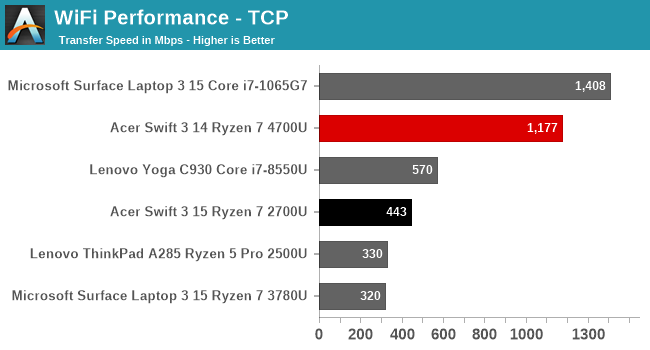
The Acer Swift 3 has very good networking performance from the 2x2 networking solution, hitting over 1.1 Gbps transfer speeds on our TCP test. We are using the ASUS ROG Rapture GT-AX11000 router, and if you’d like to check out more about the new Wi-Fi 6 testing, please check out our overview.
Audio
The Acer Swift 3 features DTS Audio with stereo front-facing speakers, and dual-microphones for Cortana support. Although the speakers are forward facing, they are on the bottom of the notebook, so can be obstructed depending on the surface the notebook is on.
Sound quality is quite good, with reasonable bottom end response for a notebook of this size. The speakers do not get overly loud, measuring 75 dB(A) one inch over the trackpad, but the sound was free from distortion.
Thermals
Thin, light, and performance. The holy trinity of laptop design. It is not always easy to achieve. Acer has a thin and light laptop, with a new 7 nm AMD Ryzen 7 4700U onboard which should help them out, but to see how the laptop responded it was run through an extended stress test of the CPU, with the GPU kicked in near the end.
As with most modern CPUs, the Ryzen 7 quickly ramps up well past its target thermal design power, hitting around 30 Watts draw at the start, but as the test goes on, that value falls back to around 18 Watts. But the power line shows several spots where it dropped back due to thermal capacity. A perfect result here would be a straight line for the CPU frequency but struggles to maintain its boosted frequency. The laptop does not seem to find a sweet spot where it can maintain temperatures either, it instead bounces from maximum power draw to minimum. The GPU also is not consistent when it is turned on around the 2300 second mark.
As this is a full stress test, it can be unfair since you are unlikely to run into a scenario where you use the system at 100% load for such an extended duration. To see how the laptop performs in a more real-world test, it was again tested using Far Cry 5 as a load source.
If anything, the results were even more disappointing. The laptop really struggled with its thermals, dropping the framerate into single digits often. The device attempted to run at around 18 Watts of power draw, slightly over the 15 Watt TDP, but in fact only averaged around 8 Watts during this run.
The laptop does not get overly loud during this load, only hitting around 45 dB(A), but clearly the included cooling system is inadequate for very heavy loads, such as gaming. Far Cry 5 is a demanding game, especially on CPU, so the SoC is even more taxed trying to balance the CPU and GPU, but overall this is a very poor result.
Software
Acer includes a few utilities which are useful, and a few that are not, such as some Norton Antivirus with a short trial period. But it is worth looking at a few pieces of software and included utilities.
The AMD Radeon Settings gives you control over the GPU settings, including disabling Vari-Bright, and seeing the system settings. It is a nice looking utility, but other than providing a few options to enable or disable, but it would be nice if you could use it to manage driver updates for the GPU rather than just copy the version numbers.
If you do want to update drivers, you can use the Acer Care Center, where you can also manage recovery media creation and support requests. This is now a standard feature on all notebooks, and Acer’s implementation is attractive and easy to use.
Acer includes a couple of links to e-tailers like Amazon and Booking.com, which are easily deleted, but also are a quick reminder that margins are thin when prices are this low.


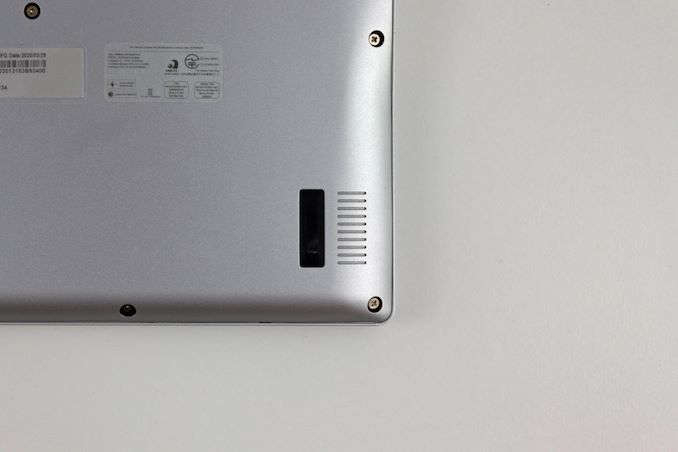
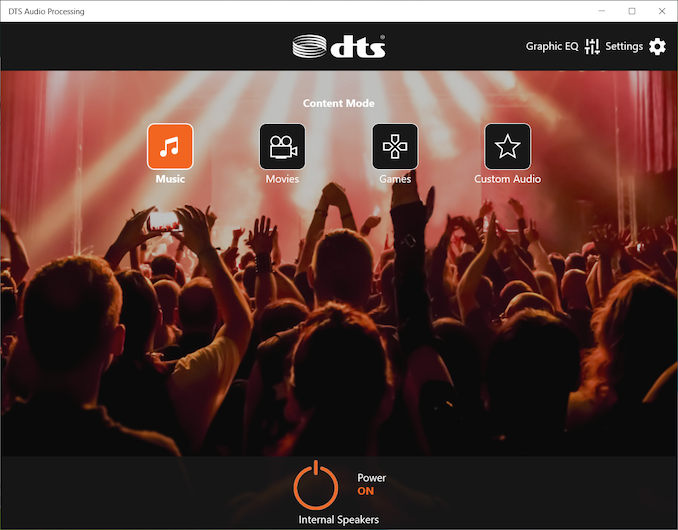
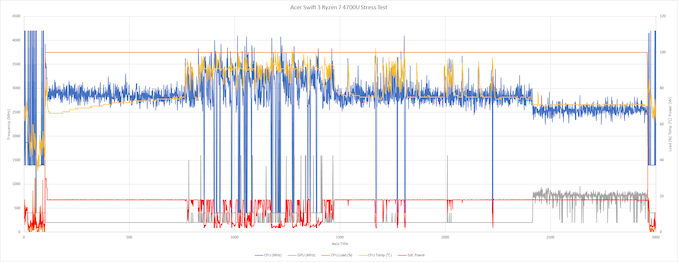
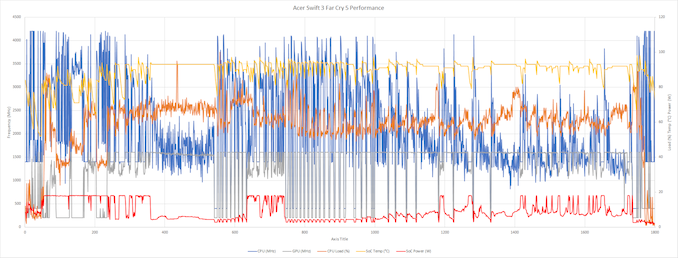
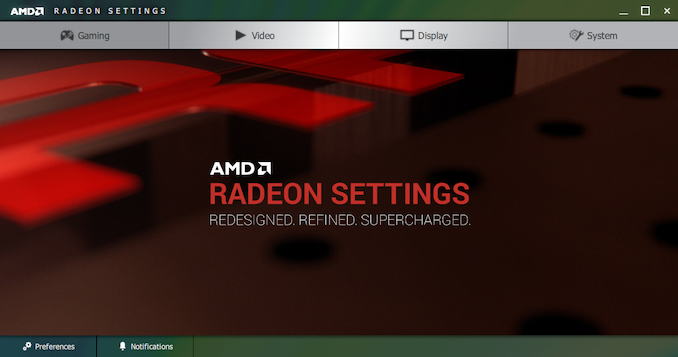

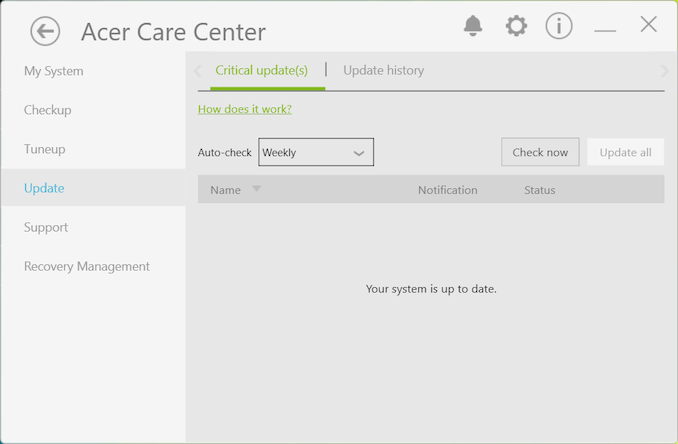








191 Comments
View All Comments
fmcjw - Tuesday, May 5, 2020 - link
Because over in Mac land they finally got the butterfly keyboard revolt over with and now talks can resume on the finer points of systems design. But it's not looking good for fine arts because the front burners have been conscripted for the A15 (MacOS on ARM) revolution.Spunjji - Wednesday, May 6, 2020 - link
Buying a CPU that doesn't have turbo is *not* a worthy trade-off unless you simply cannot afford anything better, because you'll be leaving a whole ton of performance on the table - especially when the device is plugged in.The 25% battery deficit isn't as simple as "more cores, more power" either - check out the Zephyrus G14 vs the Razer Blade 15 for a more appropriate comparison of well-designed devices. Put simply, that deficit has more to do with how this particular notebook was designed than it does to do with Ryzen 4000.
Focusing on single-thread performance when the vast majority of applications users interact with are multi-threaded doesn't really make sense, either. I'd recommend reading in a little more depth.
Omega215D - Tuesday, May 5, 2020 - link
Looks like we've got another piece of crap Intel fanboy here intent on spreading FUD on AMD's new mobile processors. So far reviews of the ASUS TUF featuring the new procs do far better on battery life and gaming performance.yeeeeman - Tuesday, May 5, 2020 - link
Looks like we've got another piece of crap AMD fanboy that cannot read the damn graphs.yankeeDDL - Tuesday, May 5, 2020 - link
The XPS and the Surface cost about twice as much as the Swift 3: they are high-end systems with high-end components, especially screens.Irata - Tuesday, May 5, 2020 - link
Actually the Dell's "as reviewed" price on At was $ 1,749.99, the Surface Laptop 3 with a 512GB SSD costs $ 2,199, so we are talking three times the price. The Yoga C930 is almost budget, costing only slightly less than twice as much as the Swift.yankeeDDL - Wednesday, May 6, 2020 - link
Thanks. You're right of course.Irata - Tuesday, May 5, 2020 - link
Eight cores vs. four cores....You have surely seen the battery life comparisons between Ryzen 4000 and Intel's eight core counterpart.
notb - Wednesday, May 6, 2020 - link
Number of cores is of less importance. Intel makes 16-core processors using 30W and 6-core chips using 100W.Comparison of 8-core SoCs are between chips made on TSMC 7N and Intel 14nm, which makes AMD much more efficient.
This comparison is for TSMC 7N vs Intel 10nm.
What matters is performance vs power and average these are similar. The gap will be minimal when Intel launches 6 or 8-core models later this year.
Spunjji - Wednesday, May 6, 2020 - link
Is there any evidence that Intel will be releasing 10nm 15W 6-8 core CPUs this year? I thought they were sticking with 4 cores on 10nm and releasing 6-8core 15W 14nm CPUs.